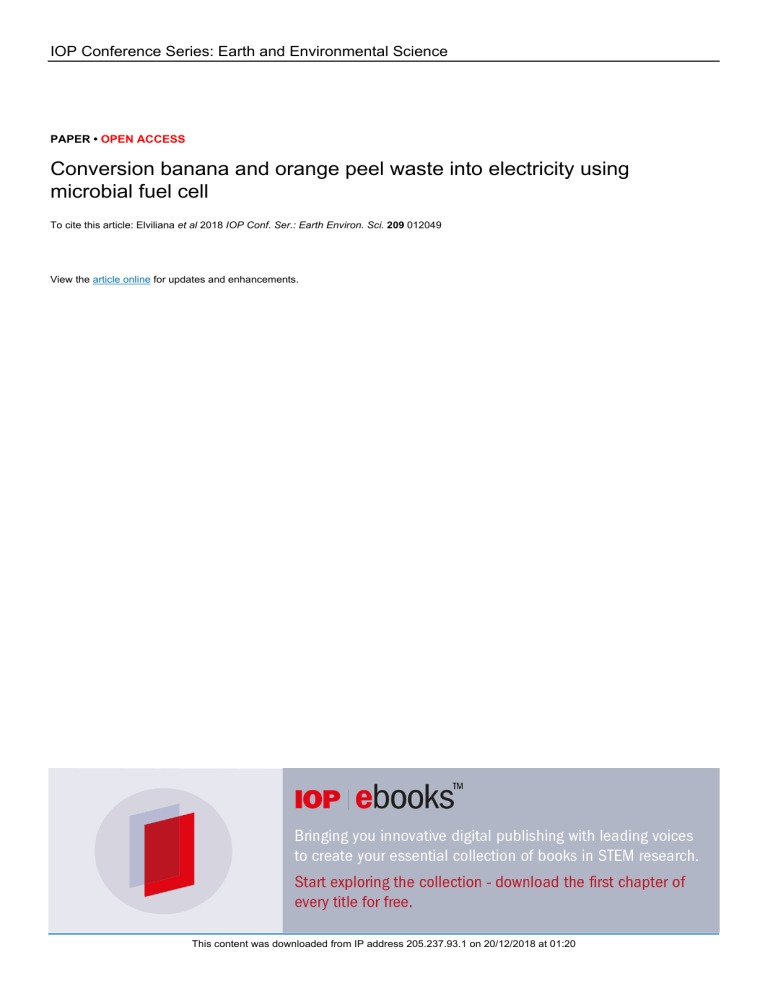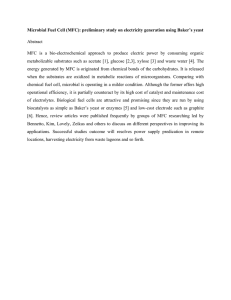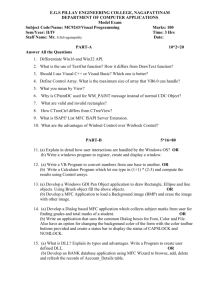Banana & Orange Peel Waste to Electricity via MFC
advertisement

IOP Conference Series: Earth and Environmental Science PAPER • OPEN ACCESS Conversion banana and orange peel waste into electricity using microbial fuel cell To cite this article: Elviliana et al 2018 IOP Conf. Ser.: Earth Environ. Sci. 209 012049 View the article online for updates and enhancements. This content was downloaded from IP address 205.237.93.1 on 20/12/2018 at 01:20 ICB2018 IOP Conf. Series: Earth and Environmental Science 209 (2018) 012049 IOP Publishing doi:10.1088/1755-1315/209/1/012049 Conversion banana and orange peel waste into electricity using microbial fuel cell Elviliana1, O S L Toding1, C Virginia1 and S Suhartini2* 1 Department of Agricultural Engineering, Faculty of Agricultural Technology, University of Brawijaya, Malang 64145, Indonesia 2 Department of Agricultural Industry Technology, Faculty of Agricultural Technology, University of Brawijaya, Malang 64145, Indonesia *E-mail: ssuhartini@ub.ac.id Abstract. Microbial Fuel Cell (MFC) is one of green technologies widely developed for future renewable energy sources. The MFC is a bio-electrochemical system that uses the bacterial growth to transform organic substrates, via oxidation-reduction reactions, from chemical energy into electricity. Two different organic substrates include banana peel waste (BPW) and orange peel waste (OPW) are investigated for their potency as a feedstock for MFCs. In this study, single chamber MFC was used in all experiment, without chemical pre-treatment or the addition of extra mediators. Both electricity current and potential values were measured for 10 days. The characterisation study indicated that OPW contains higher organics materials than that of BPW, as indicated by the VS values of 87.06% total solids/TS (OPW) and 75.32% TS (BPW). Furthermore, the results also showed that both wastes produced electricity with a slightly different amount. In average, BPW has a voltage rating of 0.492 V and electric current rating of 0.101 mA. While, OPW has in average values of 0.563 V and 0.017 mA, respectively. The study confirmed that the organic content of substrates and the microbial activity influenced the electricity produced from the MFCs 1. Introduction Electricity is one of the crucial parts in human life. The population growth and the industrial expansion have big contribution in increasing the demand for electricity. Currently, the electricity was mostly generated using fossil fuels. This high dependence use of fossil fuels has exhibited many negative consequences to the environmental sustainability. Therefore, the pursuit of new trend energy, which is sustainable, efficient and renewable production, is in progress [1]. Renewable energy technologies are needed to tackle the environmental problems include climate change and pollution due to the accumulation of anthropogenic waste [2]. In recent years, fuel cell technology has attracted great interest for its positive impacts as a clean, portable, alternative electricity production and for its compatible in many applications [3]. Microbial fuel cell (MFC) technology is one of the new approaches to generate electricity in a sustainable way through a bioelectricity generation from biomass using microorganism [4]. MFC is a new method to improve the valorisation of organic substrates/waste and to create electric energy by using the electrons exchange from the respiratory chain via oxidation and reduction reactions. Its mechanism is similar with the batteries concept, which is constituted by an anode and a cathode, thus the fuel cells receive a constant supply of energy [5]. Content from this work may be used under the terms of the Creative Commons Attribution 3.0 licence. Any further distribution of this work must maintain attribution to the author(s) and the title of the work, journal citation and DOI. Published under licence by IOP Publishing Ltd 1 ICB2018 IOP Conf. Series: Earth and Environmental Science 209 (2018) 012049 IOP Publishing doi:10.1088/1755-1315/209/1/012049 The most commonly used electron acceptor is oxygen because it can be combined with protons from the anode and it generates a non-toxic waste product [6]. Orange are citrus fruits widely consumed around the globe, as shown by the statistical database from FAO (FAOSTAT) that the worldwide production of orange was approximately 73.2 million tons in 2016 [7]. This high production leads to the generation of a large amount of orange peel waste (OPW), which accounted for 50-60% (wet weight/ww) of the processed fruit [8]. The valorisation of OPW as substrate for MFC has been reported in several studies. For example, bioelectricity was successfully generated from OPW as a renewable carbon source using a dual chamber mediator-less MFC, with the highest voltage generated of 0.59 ± 0.02 V with 500 Ω [9]. The potency of banana peel waste (BPW) for MFC’s substrates have also been investigated. Bananas are abundantly found in tropical and subtropical areas. They are native to regions of Southeast Asia and widely cultivated throughout the tropics [10]. BPW is an organic waste rich in carbohydrate and other basic nutrients, which beneficial to support microbial growth [11]. In this study, a novel approach in MFC was designed to improve waste treatment of fruit peel waste and to investigate their potency to generate electric energy. Other innovation in our method is no pretreatment was employed, no chemicals were added into the substrates, and the use of indigenous (i.e. local living) microorganisms. 2. Materials and methods Two organic waste substrates used for MFC were BPW and OPW. BPW (from Musa paradisiaca Sapientum) was obtained from the seller of fried banana, and OPW (from baby java orange) was collected from the seller of fruits juice in Malang City, East Java, Indonesia. The fruit peel was grinded using a meat grinder, to reduce the particle size before added to the MFC chamber. 4 (four) single-chamber MFC reactors were used with a total inner volume of 100 cm3 (i.e. dimension of 5 cm x 5 cm x 4 cm, LxWxH). The cathode part was perforated with nine holes, each has diameter 2 mm. The material for cathode consisted of copper plates that coated with activated carbon powder. While, the anode consisted of zinc plates coated with graphite powder. Each treatment was in duplicate. The analysis of total solids (TS) and volatile solids (VS) were carried out in accordance to the Standard Method 2540 G [12]. The voltage and electric current were measured using Digital Multi meter DT-860D WINNER for a period of 10 days. 3. Results and Discussions 3.1 Waste Characteristics Table 1 shows the results of the characterisation analysis of waste substrates used in this study. OPW has higher TS and VS value than that of BPW. A higher VS value indicated a greater amount of organic matter that readily available for biological degradation. According to Sangeetha et al. [13], the presence of organic content influence the electricity generation using MFC. A higher value in TS means a lower moisture content (MC), which found to affect the microbial activity [14]. This study shows that the MC of BPW and OPW were 82.89% and 73.45%, respectively. Wang et al. [15] found that MC of feedstock greater than 80% is suitable to be added in the composting MFC and able to produce 544±26 mV. They added that a high MC can facilitate the formation of a more electron-mobile solution, and initiate the electron transfer to the cathode. Same with the MFC that wait for the microbial growth in waste system, the water content is a crucial parameter that affects it. 2 ICB2018 IOP Conf. Series: Earth and Environmental Science 209 (2018) 012049 IOP Publishing doi:10.1088/1755-1315/209/1/012049 Table 1. TS and VS result Substrates Total Solids (%) Volatile Solids (%) MC (%ww) Ash (%ww) Banana Peel Waste 17,11 75,32 82.89 24.68 Orange Peel Waste 87,06 73.45 12.94 26,55 3.2 Microbial fuel cells performances The trends of electric potential value from BPW and OPW in 10 days period can be seen in Figure 1. The results indicated that the highest electric potential is produced from OPW compared to that of from BPW. Despite some fluctuation in the electric potential, the decline was started from day 2. From day 9 to day 10, the potential value of OPW started to increase again and reached the value of 0.586 V. Overall, the average potential of OPW was 0.563 V. For BPW, the electricity potential value was gradually increased from day 1 to day 10, with a small fluctuation occurred. The average potential value of BPW was 0.492 V. Some fluctuation in electrical potential generated may be influenced by the condition and community development of the microorganism in the MFC reactor. Also, it can be closely related to the substrates used, whether they are easy or difficult to degrade, thus differing the growth capability of microorganism in MFC [16]. 0.7 Potential (Volt) 0.65 0.6 0.55 0.5 0.45 1 2 3 4 5 6 7 8 9 10 Day OPW BPW Figure 1. The trend of potential voltage from BPW and OPW The results of the measurement of the electric currents from BPW and OPW are shown in Figure 2. It shows that BPW produced electric current greater than that of OPW. The electric current from BPW was gradually and sharply decreased from 0.242 mA (day 1) to 0.053 mA (day 10). While, for OPW, there was a relatively stable production of electric current, despite its low value. The average of electric current of BPW for 10 days was 0.101 mA, while OPW was 0.017 mA, respectively. This is in accordance with previous study by Miran et al. [9] that higher cellulose fibers in OPW limit the microorganism’s capability for degradation. The resistance value of the OPW type reaches 237.3± 21.0 Ω indicating that the current generated through the electron flow from the anode to the cathode is influenced by the space between the substrate and the electrode. Biofilms on the anode have an important role in lowering the internal resistance of the cells and can increase the electrical power in the reactor. 3 ICB2018 IOP Conf. Series: Earth and Environmental Science 209 (2018) 012049 IOP Publishing doi:10.1088/1755-1315/209/1/012049 Current Electricity (mili ampere) 0.25 0.2 0.15 0.1 0.05 0 1 2 3 4 5 6 7 8 9 10 DAY OPW BPW Figure 2. The trend of electric current from BPW and OPW 4. Conclusions The findings in this study confirmed that both OPW and BPW have a huge potency to be used as a feedstock for electricity generation using MFC technology. However, further and in-depth studies are needed, include to combine pre-treatment of substrates or to modify the MFC reactor, aiming to enhance the production of electricity. Studies on other type of organics waste substrates or biomass are also recommended for mapping the biomass potential pathways as renewable energy sources. References [1] Nitisoravut R and Regmi R 2017 Plant microbial fuel cell: a promising biosystems engineering Renewable and Sustainable Energy Review 76 81-89 [2] Winfield, J., Gadja, I., Greenman, J., Ieropoulus, I. 2016 A review into the use of ceramics in microbial fuel cells Bioresource Technol 215 296-303 [3] Zhao, X., Lie, W., Deng, Y., Zhu, J.Y. 2017 Low-temperature microbial and direct conversion of lignocellulosic biomass to electricity: Advances and challenges Renew and Sust Energ Rev 71 268282 [4] Logan B E 2008 Microbial Fuel Cells (New Jersey: John Wiley & Sons) p 4 [5] Tommasi T and Lombardelli G 2017 Journal of Power Sources 356 438-447 [6] Wu, Y., Yang, Q., Zeng, Q., Ngo, H.H., Gup, W., Zhang, H. 2017 Enhanced low C/N nitrogen removal in an innovative microbial fuel cell (MFC) with electroconductivity aerated membrane (EAM) as biocathode Chemical Engineering Journal 316 315-322 [7] FAOSTAT 2016 http://faostat.fao.org/site/567/DesktopDefault.aspx?PageID = 567#ancorretrieved 2018 June 14, 2018 [8] Martin, M.A., Siles, J.A., Chica, A.F., Martin, A. 2010 Biomethanization of orange peel waste Bioresource Technol 101 8993-8999 4 ICB2018 IOP Conf. Series: Earth and Environmental Science 209 (2018) 012049 IOP Publishing doi:10.1088/1755-1315/209/1/012049 [9] Miran, M., Nawaz, M., Jang, J., Lee, D.S. 2016 Conversion of orange peel waste biomass to bioelectricity using a mediator-less microbial fuel cell Science of the Total Environment 547 197-205 [10] Tock, J. Y., Lai, C.L., Lee, K.T., Tan, K.T., Bhatia, S. 2010 Banana biomass as potential renewable energy resource: A Malaysian case study Renew and Sust Energ Rev 14 798-805 [11] Essien, J.P., Akpan, E.J., Essien, E.P. 2005 Studies on mould growth and biomass production using waste banana peel Bioresource Technol 96 1451-1456 [12] APHA 2005 Standard Methods for the Examination of Water and Wastewater 21st edition (Washington: Water Environment Federation) [13] Sangeetha, T., and M. Muthukumar. "Influence of electrode material and electrode distance on bioelectricity production from sago‐processing wastewater using microbial fuel cell."Environmental Progress & Sustainable Energy 32, no. 2 (2013): 390-5. [14] Tsunatu, D.Y., Azuaga, C., Agabison, J. 2014 Evaluation of the effects of total solids concetration on biogas yield of agricultural waste International Research Journal of Environment Sciences 3 70-5 [15] Wang, X., Tang, J., Cui, J., Liu, Q., Giesy, J.P., Hecker, M. Synergy of electricity generation and waste disposal in solid state Microbial Fuel Cell (MFC) of cow manure composting 2014 Int. J. Electrochem. Sci. 2014 9 [16] Logrono, W., Ramires, G., Recalde, C., Echeverria, M., Cunachi, A. 2015 Bioelectricity generation from vegetables and frutt wastes by using single chamber microbial fuel cells with high Andean soil Energy Procedia 75 2009-14 5




